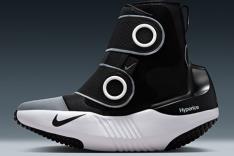If you'd told the young, skinny me all of this 30 years ago, as I watched those bodybuilders flex and strut and flex some more, I wouldn't have believed you. How could these huge guys be so lean if their ability to put on weight also predisposed them to gain excess fat?
The obvious answer is because they trained hard to gain muscle and then dieted hard to lose fat. The subjects in the Laval University study were all sedentary. We can't say what the results would've been if they'd lifted during the 100 days of overfeeding, only that they probably would've gained less fat and more muscle.
But there was another factor in the bodybuilders' results that I didn't account for at the time.
Part 4: Shot Class
The first studies linking synthetic testosterone to increased muscle and strength were published in the early 1940s. But it wasn't until the mid 1950s that anabolic drugs were clearly and permanently linked to sports performance.
Americans dominated weightlifting in the early postwar years. But in 1953, the Soviet Union won its first world championship, and in 1954 a doctor for the Soviet team admitted to his American counterpart that his athletes were injecting testosterone. The American doctor, John Ziegler, went on to develop Dianabol, the first oral steroid, and Winstrol, an injectable.
You know the rest of the story. By the 1960s steroids were pervasive in strength and power sports, from the Olympics to the NFL. They were especially important to the new and fast-growing sports of powerlifting and bodybuilding. But at the time only the insiders in sports, fitness, and exercise science understood just how important they were.
The fitness industry, where I was just beginning to learn my way around, had a vested interest in obscuring the line where human potential ended and anabolic drugs took over.
Who would read about Mr. Olympia's sleeve-busting biceps workout if it included a list of the illegal, expensive, and potentially dangerous drugs he took to build arms equal in circumference to his skull?
The article might include a list of the nutritional supplements he took, if those supplements happened to be sold by the same company that published the magazine. But mostly it would focus on exercises you saw every day in the local gym, only with bigger weights and veinier arms.
In sports, athletes were able to exploit a generation of sportswriters who didn't train and had no idea what could be achieved without drugs. My favorite example is a Baseball America article from 2002. Under the subhead "Raw Talent Takes Time" is this paragraph about how Jose Canseco transformed himself from a middling prospect to a superstar:
"But 1985 saw a different Canseco. Already considered less than focused, he matured dramatically after coming to grips with his mother's death early in the previous season. He also added 30 pounds in offseason workouts."
The highlighted part wasn't italicized in the original. It was just a sentence dropped into an article describing Canseco's amazing leap from hitting 15 homers in the lower levels of the minor leagues in 1984 to hitting 36 in the upper levels in '85, and then to becoming American League Rookie of the Year in '86 and MVP in '88.
More from Men's Health: The 100 Fittest Men of All Time
You'd think that by 2002 no sportswriter would've been naive about the effects of steroids. Canseco, who had recently retired, was already talking about his own steroid use, and claimed most ballplayers were doing the same thing. But then as now, the dramatic narrative of athletes triumphing over adversity is a lot more entertaining if you leave out the chemistry.
So what exactly do steroids add to conventional training? In a landmark 1996 study in the New England Journal of Medicine, men who received testosterone injections gained twice as much strength and several times as much lean mass as men who did the exact same training program and followed the exact same diet. In 10 weeks the juiced subjects gained 13 pounds of lean mass, compared to 4 pounds for those who got a placebo. All the subjects had lifting experience.
Phillips regards these results as a clear indication of the difference between training with or without steroids. An average guy can hope to gain 4 to 7 pounds of muscle in 10 to 12 weeks of serious training, and that's only if he's either new to lifting or returning from a layoff. The more experienced and dedicated you are, the less you can gain.
It's possible for an individual to gain more, just as it's possible for someone to gain nothing, or perhaps even lose some size, despite working as hard and eating as well as he can. But neither of those is likely.
So if you hear about a training program or see an ad for a supplement promising results that exceed these norms, you can be sure of one thing: Someone is just making stuff up.
More: 7 Facts About Your Muscles
 Stay in shape in a fitness class or read more fitness articles.
Stay in shape in a fitness class or read more fitness articles.
- 3
- of
- 3
About the Author

Get ACTIVE on the Go


Couch to 5K®
The best way to get new runners off the couch and across the finish line of their first 5K.
Available for iOS | Android







Discuss This Article